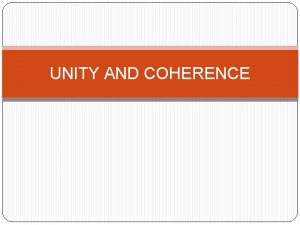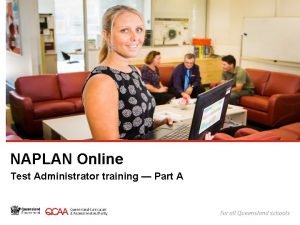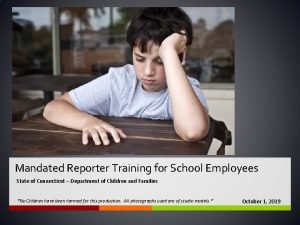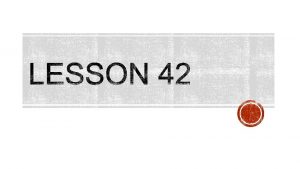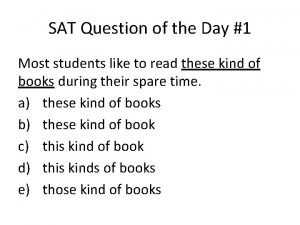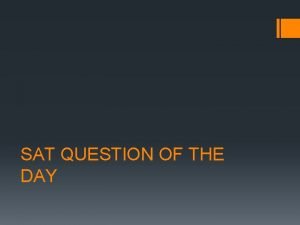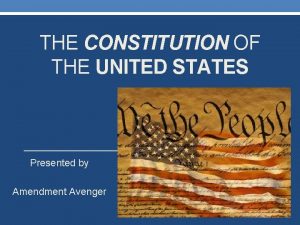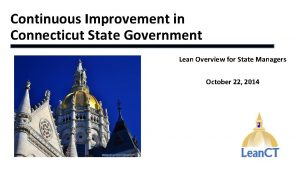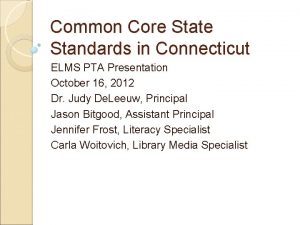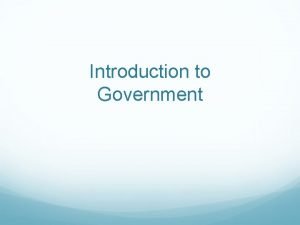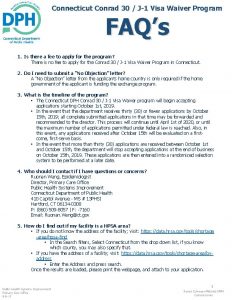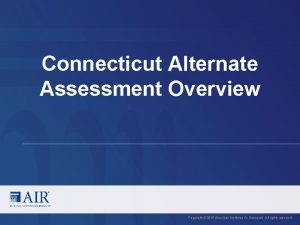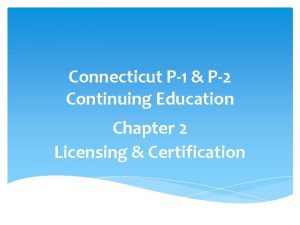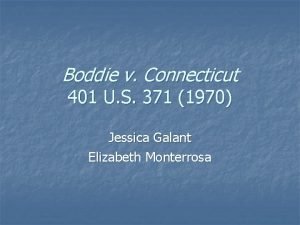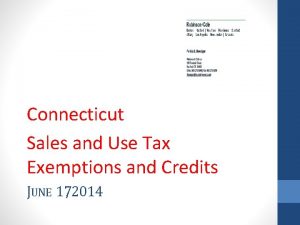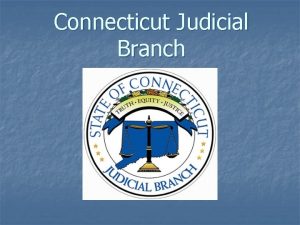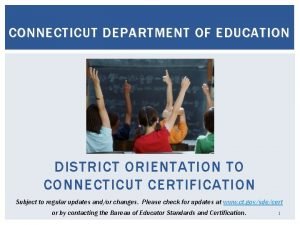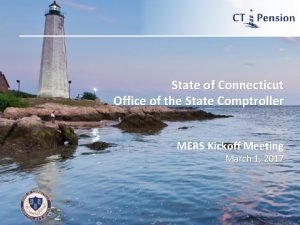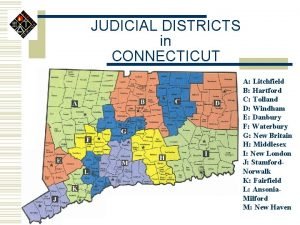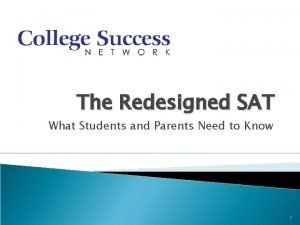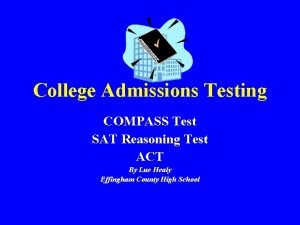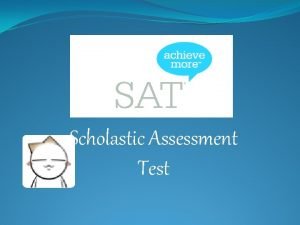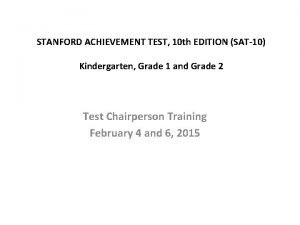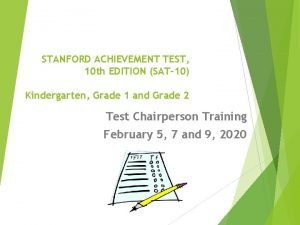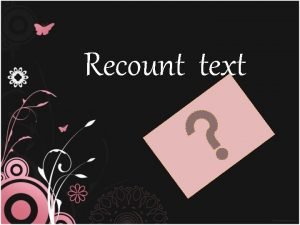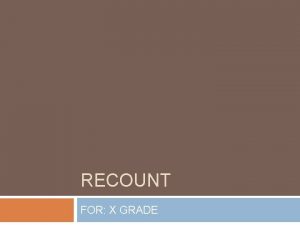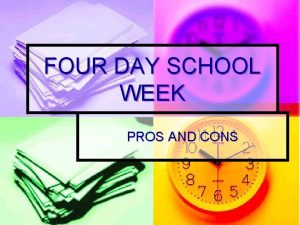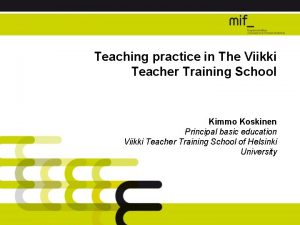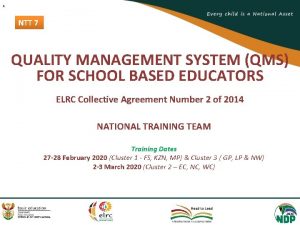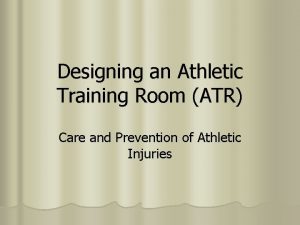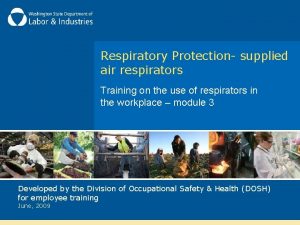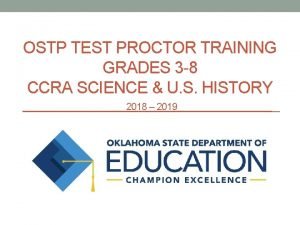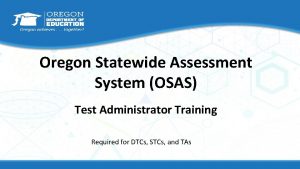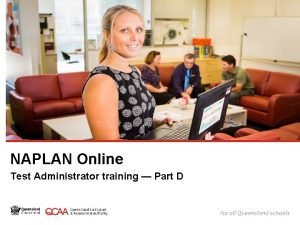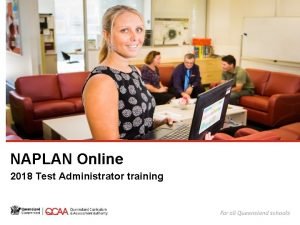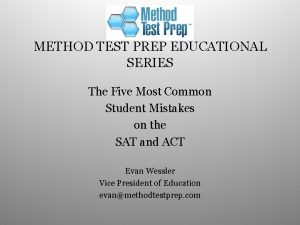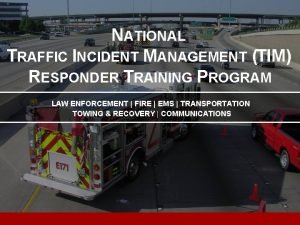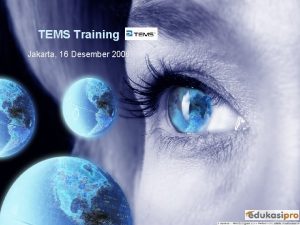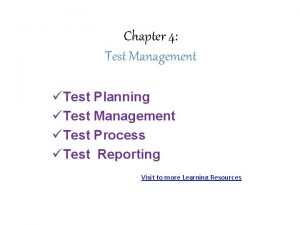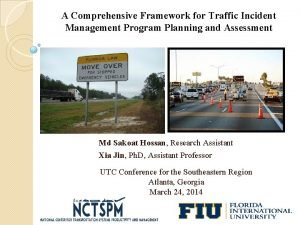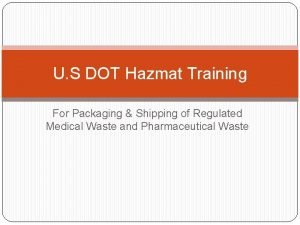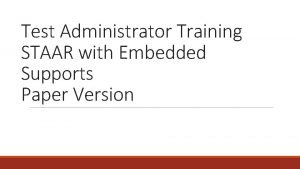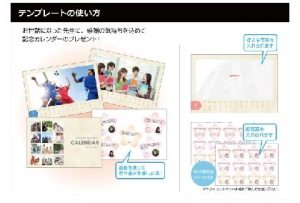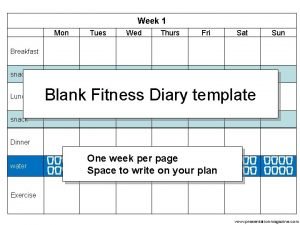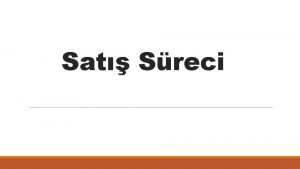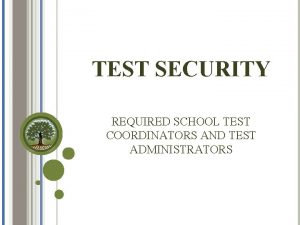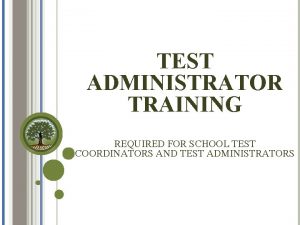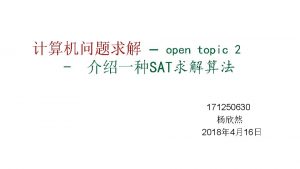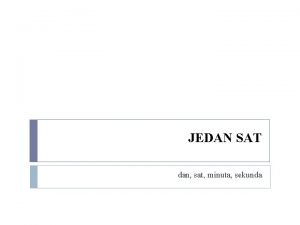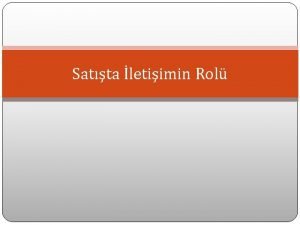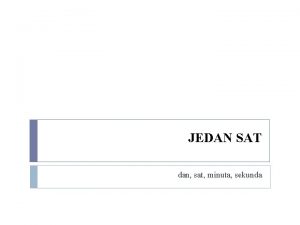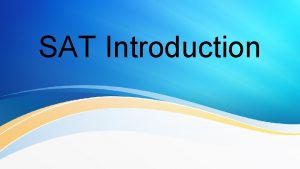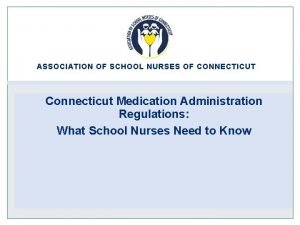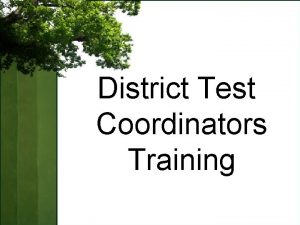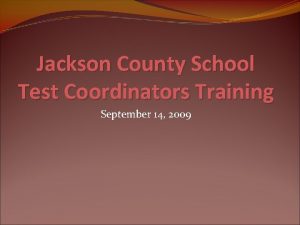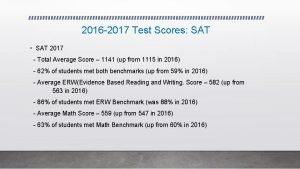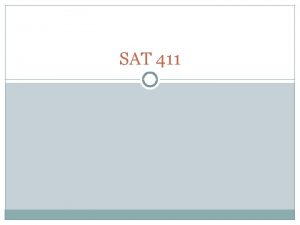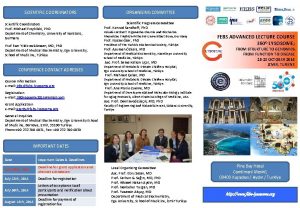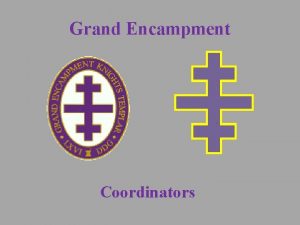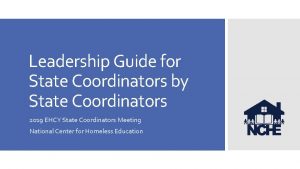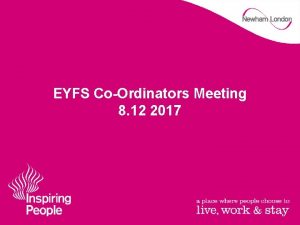Connecticut SAT School Day Training for Test Coordinators










































































































































































- Slides: 170

Connecticut SAT® School Day Training for Test Coordinators 2019 Administration Michelle Rosado, CSDE Deirdre Ducharme, CSDE Caryn Burkes, College Board

Agenda Our goal today is to provide an overview of responsibilities related to the March and April 2019 Connecticut SAT School Day administration. • Updates • Accommodations • Planning for Test Day • Planning Rooms & Staffing • Returning Materials and Makeups 2

Test Dates Primary Test Day: March 27, 2019 If your school is closed on the primary test date due to weather, testing will be conducted on the make-up dates. April 9, 2019 Accommodated Testing Window: March 27 -April 9, 2019 April 9 -23, 2019 Makeup Test Days: April 23 and 24, 2019 3

Key Dates Activity March 27 Administration April 9 Administration CB Accommodations Requests Closed 2/5/19 English Learner 50% ET requests Closed 2/19/19 Received by 2/8/19 3/5 -3/7/19 3/19 -3/21/19 (adjusted for spring break if necessary) 3/26 -3/28/19 (adjusted for spring break if necessary) 3/27/19 4/9/19 3/27 - 4/9/2019 4/9 – 4/23/2019 3/29/19 4/11/19 4/23/19 4/24/19 (if necessary) Coordinators Planning Kit Pre-Administration Materials Shipment Test Materials Arrive in Schools Test Day Accommodated Testing Window Deadline to submit makeup material requests Make-up Test Day 4

Connecticut SAT School Day Manuals • There are three different manuals. • Include policies and procedures for testing. • Please share the appropriate manuals with your test day staff. • As you continue this training, you will see this icon , which points out related information from the manuals. 5

Contact Information Purpose Who Phone E-mail • Test Administration Procedures Questions • Test Materials College Board 855 -373 -6387 satschoolday@ collegeboard. org • CT SAT School Day Questions Michelle Rosado 860 -713 -6748 michelle. rosado@ct. gov • Designated Supports and Accommodations Deirdre Ducharme 860 -713 -6855 Questions Janet Stuck 860 -713 -6837 • CTAA and NGSS Alternate Assessment deirdre. ducharme@ct. gov Janet. Stuck@ct. gov 6

Communication CSDE Student Assessment Newsletter • Sent to the DA identified with the TIDE DA user role, as well as the secondary contact. CT SAT Test Coordinators and English Learner Assessment Coordinators also receive a copy; additionally, anyone can subscribe. CSDE CT SAT Web Site https: //portal. ct. gov/SDE/Student. Assessment/SAT/Connecticut-SAT-School. Day College Board Web Site • https: //www. collegeboard. org 7

Office Hours • Time set aside on a weekly basis for schools and districts to call in and get questions answered. • Weekly calls on Wednesday from 2 -3 pm beginning on March 6, and running through March 20. • Registration links will be e-mailed. • CSDE and College Board are on the calls. 8

The Importance of Training New this year, all Test Coordinators will be asked to complete an online survey indicating that training was provided to staff who will be administering the test. • The Connecticut SAT® School Day is a standardized test. • Valid results DEPEND on STRICT ADHERENCE to the procedures in this training. • Please pay special attention to the security requirements, denoted by a padlock icon. We’re counting on your compliance. 9

Test Security Breaches of test security include, but are not limited to: • analyzing/copying test items • coaching students • giving students answers, and/or changing students’ answers • allowing students access to digital, electronic, or manual devices (except approved accommodations) Cell phone use by students in testing rooms is prohibited! 10

Participation - Connecticut General Statues 10 -14 n (b) (1) For the school year commencing July 1, 2015, and each school year thereafter, each student enrolled in grades three to eight, inclusive, and grade eleven in any public school shall, annually, take a mastery examination in reading, writing and mathematics during the regular school day. For the school year commencing July 1, 2018, and each school year thereafter, each student enrolled in grades five eight and eleven in any public school shall annually take a state-wide mastery examination in science during the regular school day. 11

Participation Federal law continues to expect full participation of all students on the state summative assessments. The minimum standard for the participation rate is at least 95 percent of all students and all student groups for each subject. For accountability purposes at the district and school level, the CSDE evaluates the participation rate for all students, as well as students in the "high needs" subgroup for all content areas. 12

Testing Students at Out of State and In State Non-Approved Schools Connecticut public school districts are responsible to test students in the Public School Information System (PSIS) who are enrolled in out-of-state facilities or are enrolled in state non-approved schools. 13

Score Reporting • Students receive their Connecticut SAT test results through their online College Board account. • Districts can access the test results through the College Board online score reportal. • Summary and student results will also be posted on CSDE’s Ed. Sight system http: //edsight. ct. gov 14

What’s New in 2019?

Test Books • Green test books have been eliminated. Students will use purple for standard. • Some accommodated students will use purple and some blue. • Check the NAR to determine book color.

Accommodated Testing Window • For the 2019 test, students testing with approved accommodations who previously tested within the two-day window will now be allowed to test within a two-week accommodated window. • The additional days are provided to offer flexibility when testing students with eligible accommodations. • Schools can still elect to test all nonstandard testers beginning on the primary test date or schedule testing across the window to manage space and/or room constraints.

Accommodated Testing Window Students who are approved for accommodations will fall into these groups, as indicated on the Non-Standard Administration Report (NAR) available in SSD Online: • Those who will use standard (purple) testing materials must test on the primary School Day test date (either March 27 or April 9, as selected by your school). • Those who will use accommodated (blue) testing materials may test on any day during the accommodated testing window. • 100% extended time students and other two day testers must be tested on two consecutive days.

Planning for Accommodated Testing • Meet with staff to determine test schedule for students eligible to test in the accommodated window. If possible, start testing these students on the primary test date. • For accommodated testers that don’t require multiple days, student testing must be completed on one of the days during the window. • Students who test over two days must test on consecutive days, and their testing must be completed within the accommodated window. • If a student is absent for the second day of testing, they can resume on the next day they return to school.

Planning for Accommodated Testing • Students using blue test books who are absent on test day should test later in the accommodated testing window using the same testing materials. • If you have accommodated students testing within the window who require a makeup because of an irregularity, contact the SSD office. • Once you have sent in any testing materials from the primary test date, hold all other accommodated testing window materials until all accommodated testing is complete.

EL Students • EL students testing with 50% extended time will use the same materials as accommodated students approved for 50% extended time testing. • They can be tested in the accommodated room as long as no additional accommodations are being administered that might require different timing or breaks.

Grade 12 Students • No grade 12 students will be permitted to take the CT SAT School Day in 2019. • Only grade 11 students who are listed in PSIS as grade 11 take the CT SAT School Day. • No Grade 8, 9, 10 or 12 students are permitted to take the Connecticut SAT School Day. Any tests received for these students will NOT be scored.

Revised Staff Titles Past Title Current Title Test supervisor Test coordinator Associate supervisor Hall proctor Proctor Room proctor Room monitor Hall monitor

Revised Titles of Forms • The Supervisor’s Irregularity Report has become the Irregularity Report (IR). • The Supervisor’s Report Form has become the Coordinator Report Form (CRF).

Revised Answer Sheet • The SAT answer sheet now includes pages for the SAT with Essay. • Before the test begins, students will be instructed to fill in the bubble for “SAT” as the test they are taking. • The proctor scripts include an explanation to students that they won’t be using the SAT Essay portion of their answer sheets.

Monitoring • The CSDE will be sending staff to schools during the 2019 administration of the CT SAT School Day for the purpose of monitoring test administration. • Seeking volunteers • Need 5 schools per date

Reminders for 2019

PSIS Registration Module It is important to keep the following 7 fields updated in the PSIS Registration Module for the Connecticut SAT School Day in order to generate appropriate student rosters and student labels, and for accurate final reporting. · Special Education (SPED) Status; · Free and Reduced Lunch (FRL) Status; · English learner (EL) Status; · Military Family; · Homeless; · Recently Arrived EL; and · Section 504 Status.

Student Registration • The CSDE submits three files to the College Board. • All Grade 11 students in PSIS registration as of April 16, 2019, will be registered by the CSDE through a bulk registration process. • Please make sure your district’s PSIS Coordinator maintains an updated list of Grade 11 students.

Student Registration • Schools will receive Pre‐ID labels for all students who are in the PSIS registration file as of February 4, 2019 for March testers and February 19, 2019, for April testers. • Please note that the student information in your local information system (such as Power. School) is not the same as PSIS registration. • Please check with your district’s PSIS coordinator to determine the list of Grade 11 students. • The CT SAT School Day program does not use TIDE.

Rosters • Schools will create their own rosters of students taking the standard CT SAT. • The Nonstandard Administration Report or NAR includes ALL students who are approved for accommodations in SSD and will be available approximately 4 weeks prior to testing.

Answer Sheets and Labels • Schools will receive student answer sheets in March. This will allow schools to schedule time prior to the test to have students grid required demographics. • All students must grid demographics! (label or no label) This differs from PSAT administration. • Pre-Id labels will be generated for all Grade 11 students who are in PSIS as of February 4 or 19 depending on test date. These labels must be affixed to the answer booklet prior to testing. • The answer sheet includes a place for students to indicate their four free score sends.

Student Resource for Sending Scores Available on CSDE SAT Web Site All college codes are included in the Student Answer Sheet Instructions booklet.

Test Makeups • Students who miss the initial test administration, will be required to take the SAT on the make-up date, April 23 or 24, 2019. • Schools will request makeup materials through an online survey. Information will be provided before testing regarding access. • Schools will receive all new standard materials for the makeup administration. Schools should retain any unused answer sheets for the make-up test. • Students testing during the accommodated testing window should complete testing when they return to school but before the end of the testing window using materials already on-site.

Reminders for Students/ Parents • There is no penalty for guessing! • Free official SAT practice is available on Khan Academy! • Students should be encouraged to create a College Board account. • Students do not need to register online or pay for this exam. • Each student gets 4 free college score sends. • Students may cancel their scores. • Students can chose which scores to send to colleges using score send. • All scores earned on the CT SAT School Day are college reportable!

School Day and Weekend SAT Testing – An Important Reminder If your school also offers weekend SAT testing, remember: • Connecticut SAT School Day materials sent to the test coordinator must never be mixed with weekend testing materials. • Mixing materials could lead to delays and possible cancellation of scores.

Testing Special Education, 504 and EL Students

Connecticut SAT School Day Accommodations Used for state accountability system and college admission Examples of most common accommodations: American Sign Language (ASL)- test directions only Braille Color Overlay Computer Extra/Extended Breaks Large Print Booklet Magnification Device Modify Setting Multiplication table Noise Buffering Reader Scribe Signed Exact English -test directions and test content Speech-to-Text (CB Assistive Technology) 4 Function Calculator Text-to-Speech for all test content (CB MP 3 audio) Time Extension 50% or 100%

Time Extension vs. Extra Breaks • Time Extension allows the student extra time to complete the test. This is time working in an open test booklet. Available for 50% or 100% above standard time. • Extra/Extended Breaks allows the student breaks from testing. The test booklet must remain closed during the break.

Time Extension • Provided to students whose disabilities, processing, physical needs require additional time to complete a timed assessment. Things to Consider • Available as 50% or 100% time extension. With 100% extended time the student may need to be tested over 2 days. • Available for Evidence Based Reading/Writing or Mathematics, or for both. • Student must remain in room for all of the extended time requested even if they finish early. • Students approved for time extension automatically receive extra breaks.

Types of College Board Accommodations - Timing Accommodatio Day(s) What to Know n 50% extended Student will receive extended time for ALL sections. time for 1 Day Student must use the entire time for which they are approved. reading Student will automatically be approved for extra breaks. Student will receive extended time only for the math sections. 50% extended 1 Day Student must use the entire time for which they are approved. time for math Student will automatically be approved with extra breaks. 100% extended Students will receive extended time for ALL sections. time for 2 Day Students must use the entire time for which they are approved. reading Student will automatically be approved with extra breaks. Student will receive extended time only for the math test. 100% extended 1 Day Student must use the entire time for which they are approved. time for math Student will automatically be approved with extra breaks.

Types of College Board Accommodations - Breaks Accommodation Day 1 Extra Breaks Day Extended Breaks 1 Day Breaks as Needed 1 Day What to Know Given a break halfway through longer sections and a break after every section. Given breaks at the standard time but breaks are typically twice as long. Some students who request extended breaks may need additional accommodations such as permission to eat, take medication, or permission to test blood sugar. These must be requested specifically. Typically given to students with physical or medical conditions. Breaks are granted as requested by the student during the exam. Timing of the test is paused during the break. Some students who request breaks as needed may need additional accommodations, such as permission to eat, take medication, or permission to test blood sugar. These must be requested specifically.

Types of College Board Accommodations – Testing Blood Sugar Accommodation Day(s) What to Know Permission to Test Blood Sugar 1 Day Will use standard time, unless approved for other timing or break accommodations. Approval to test blood sugar does not include approval to take additional breaks. If a student needs beyond the standard breaks, the student should request extra breaks, extended breaks, or breaks as needed. Approval to test blood sugar does not permit the student to have a cell phone, unless he/she is approved for a cell phone/medical device in the testing room.

Types of College Board Accommodations – Test Setting Accommodation Day(s) What to Know Small Group Testing Home/Hospital Testing 1 Day Will depend on the number of students in the group and the size of the room. There is no minimum number of students that must be tested in a room, so if the school has the capacity to put 10 students in a room, there is no need to request a small group accommodation. Requested through SSD Online. Student with a disability that prevents him/her from attending school will be administered the test at a location other than school (e. g. , home or hospital).

Types of College Board Accommodations – Reading/Seeing Text Accommodation Day(s) MP 3 Audio 2 Days Reader 1 Day What to Know Audio version of the test, delivered on a flash drive. Student automatically receives 100% extended time (plus additional time on the writing and language test) and extra breaks on all sections. Student must use the entire time for which they are approved. They cannot move to the next section or end the assessment when they are finished, even if they are the only student testing. Student will be read the SAT aloud by an adult. Student must be in a one-to-one setting with an adult. Readers must meet testing staff requirements (i. e. paraprofessional, teacher, principal, etc. ) Student automatically receives 50% extended time and extra breaks on all sections. Student must use the entire time for which they are approved. They cannot move to the next section or end the assessment when they are finished, even if they are the only student testing.

Types of College Board Accommodations – Reading/Seeing Text (Continued) Accommodation Day(s) What to Know Digital version of the test, delivered on a flash drive. For use with screen readers and other assistive technology Assistive Student is automatically given 100% extended time on the writing Technology 1 Day and language section only. Compatible Student must use the entire time for which they are approved. They (ATC ) cannot move to the next section when they are finished, even if they are the only student testing. Student will receive either a EBAE with Nemeth Math or UEB with Nemeth Math test book. Braille 1 Day Student will receive a Braille Figure Supplement Typically approved with another accommodation such as scribe or braillewriter to record answers. Student will receive test directions, the only listening portion of the SAT, in ASL by an adult. American Sign 1 Day Interpreters must meet testing staff requirements (i. e. Language (ASL) paraprofessional, teacher, principal, etc. )

Types of College Board Accommodations – Recording Answers Accommodation Day(s) What to Know Writer /Scribe* 1 Day Student will have an adult transcribe answers onto the answer sheet. Student automatically receives 50% extended time and extra breaks on all sections. Student must use the entire time for which he/she is approved. Student cannot move to the next section or end the assessment when finished, even if he/she is the only student testing.

Types of College Board Accommodations – Other Accommodation Day(s) Permission for Food/Medication 1 Day What to Know Will use standard time, unless approved for other timing or break accommodations. May need to request for breaks as needed Epi. Pens are permitted in the testing room without the need for accommodations. They must be placed in a clear bag and stored under the student’s desk during testing. For other medications, contact the SSD office.

English Learner (EL) Students • Schools with EL students who require 50% extended time will no longer apply under State Allowed Accommodations. Schools will apply for these supports under SSD online. • EL students who use 50% extended time will receive a college reportable score. Go to English Learner Support Dashboard >

English Learner Student Supports Used for college admission Advance approval required? • 50% Extended Time Yes • Written Test Directions in: Albanian; Arabic; Bengali; Chinese-Mandarin; No Gujarati; Haitian Creole; Hindi; Polish; Portuguese; Russian; Spanish; Urdu; Vietnamese • Native Language Reader – test directions only No • 2019 List of Bilingual Dictionary Word-to-Word Glossaries include, but No are not limited to: Albanian, Arabic, Bengali, Bosnian, Burmese, Cambodian/Khmer, Chinese/Mandarin, French, Gujarati, Haitian Creole, Hindi, Italian, Polish, Portuguese, Russian, Somali, Spanish, Urdu, Vietnamese.

50% Extended Time for EL Students Support Day(s) What to Know EL – 50 % Extended Time (students must remain in testing room for the entire testing time. ) 1 -Day • • Student will receive extended time for ALL sections. Student must use the entire time for which he/she is approved. Student will automatically be approved for extra breaks. *Any extended time supports provided to EL students only applies to the CT SAT School Day.

English Learner Supports 50% Extended Time • Result in reportable scores • 50% extended time on each section of the test. • Must sit for the entire time allotted and cannot go ahead in the test even if they are the only one testing. • Although not an accommodation, needs to be identified in SSD Online to create accurate rosters (students will be listed on the Nonstandard Administration Report). • EL students using 50% extended time can be tested with other students using the same timing and test materials.

Accommodations – Already Approved Students • Students with Approved accommodations through College Board from previous years, require no action unless you need to make changes. • Test Materials will be shipped for these students based on the test materials needed for their existing approved accommodation in the SSD Dashboard.

Changing an Accommodations Request View Decision Letter Create change Request Resubmit Request 1. Click on the button 2. Choose Create change Request

Changing an Accommodations Request (continued) • Print, complete, and fax in the change request form to College Board’s secure electronic document system. • AFTER SUBMISSION: Check the SSD Dashboard for status change to Document Review

Practice Resources for Accommodated Testers • Practice Tests for assistive technology can be found at: https: //collegereadiness. collegeboard. org/sa t/practice/full-length-practice-test-assistivetechnology • Practice Tests for MP 3 audio can be found at: https: //www. collegeboard. org/studentswith-disabilities/after-approval/taking-sataccommodations • Practice Tests for Braille and large print may be requested by contacting SSD Customer Service (212 -713 -8333) or ssd@info. collegeboard. org

Medical Exemptions

Key Terms

Terms You Need to Know Common Terms Types of Forms • CSDE – Connecticut State Department of Education staff oversee the Connecticut SAT School Day and are ready to answer your questions. • TRMR — The Testing Room Materials Report form is used to account for testing materials in the testing room. • SSD – Services for Students with Disabilities staff oversee testing of students with accommodations. - • AI Code A six-digit code that identifies an attending institution (a school in which a student is enrolled). • NAR – The Nonstandard Administration Attendance Roster of students testing with accommodations. • CRF — The Coordinator Report Form is used to tally used and unused materials for processing. • IR — The Irregularity Report form is used to report any incidences or irregularities during an administration.

Terms Used for Testing • Standard administration — Testing with no additional time or breaks, or alternate test formats like Braille or MP 3. • Nonstandard administration — Testing with College Board-approved accommodations or EL 50% extended time • Extended time — Testing with either 50 percent or 100 percent additional time.

Terms Used for Nonstandard Testing • NAR — The Nonstandard Administration Report is the roster of all students who are approved for testing with accommodations such as 100% extended time, which is accessed through the SSD online system by the SSD Coordinator. • SSD Coordinator — Works with students to apply for accommodations, accesses and prints the NAR and provides it to the test coordinator, and assists the test coordinator in administering the test with accommodations. • English Learner Supports — Used to provide Time Extension of 50% for English Learners (EL). Applies only to the CT SAT School Day.

Before the Test

Before the Test Prepare Your School Prepare Yourself Build Your Lists Plan Your Space Plan Your Staff Build Your Schedule Prepare Your Students Prepare Your Materials

AI Codes • Schools are assigned a six-digit school code representing the attending institution (AI code) or high school code. • AI Codes are required to pre-ID students, administer College Board exams, apply for student accommodations, and receive materials and students’ exam scores. • AI codes are six digits, usually starting with 07. • The AI code is the only code you will need forms and reporting.

Before the Test Prepare Your School Prepare Yourself Build Your Lists Plan Your Space Plan Your Staff Build Your Schedule Prepare Your Students Prepare Your Materials

Prepare Yourself • • • Participate in mandatory Coordinator’s training - either live or online Read the Coordinator’s manual Distribute Testing Room manuals to proctors and SSD coordinator(s) for their review Review the contents of the Coordinator Planning Kit which arrived in early February Plan ahead!

Before the Test Prepare Your School Prepare Yourself Build Your Lists Plan Your Space Plan Your Staff Build Your Schedule Prepare Your Students Prepare Your Materials

Build Your Lists • Identify students who are testing and create a list of students to determine how many testing rooms and staff you will need for administering the test: Master Student List • Pull the list of eligible students from your school student information system or work with your district assessment coordinator to get the list of students from PSIS. • Test Coordinators will work with the SSD Coordinator to understand numbers of students testing with accommodations by using the NAR.

Build Your Lists Nonstandard Administration Report (NAR) • Lists ALL students approved for accommodations • Grouped into two sections: Students that must test on the primary day and students that test in the accommodated window • Includes what test book color and the script name the student should use • Available 4 weeks prior to the test • Students approved for EL 50% extended time will be listed with other 50% extended time test takers.

Managing Students on the NAR • The SSD Coordinator will run the NAR from the SSD Online Dashboard. • Select SAT • Enter AI code and Primary Test Date

Managing Students on the NAR • When generating the NAR, one of the following scenarios will occur: • There are no students approved for accommodations. • All students with approved accommodations match a student registration from the CSDE-provided February Pre-ID file. • There are students with approved accommodations with a matched student registration AND students who are approved but did not match a registration from the CSDE-provided Pre-ID file.

Managing Students on the NAR No students approved In the situation where a school has no students approved for accommodations, the SSD Coordinator will get the following message when running the NAR.

Managing Students on the NAR All students listed • When all students with approved accommodations in SSD Online match to the student Pre-ID information provided by CSDE, SSD Coordinators will see a list of students, with their College Board SSD#. • The SSD Coordinator will click the “Create SAT Nonstandard Administration Report” to generate the report for printing.

Managing Students on the NAR • It is possible that not all students with approved accommodations will match to the CSDE-provided Pre-ID information. • Common reasons for this include: Mix of matched and unmatched students • • Students that transfer to your school after February pre-ID file was submitted • Students whose information in SSD Online is too different from what was provided by CSDE. When this happens, SSD Coordinators will follow a two step process to generate the NAR.

Managing Students on the NAR Mix of matched and unmatched students • Step 1: View list of matched students and click “Continue” • Step 2: Select the additional students that will be testing and their test type. Select “Create Nonstandard Administration Report” to generate the NAR.

Best Practices • Create your roster in Excel or Word format. • This allows you more flexibility to sort and print your rosters for your staff. • You should also create testing room rosters after assigning students to testing rooms. Room rosters should be provided to Proctors on test day. • Your roster is an important record-keeping document — make a copy of your annotated roster and keep it on file for 6 months following the test. You will return the original with your answer sheets. Using Your Roster

Best Practices • The district PSIS coordinator will need to follow these steps to print a roster: 1. log into the PSIS Registration Module; 2. click on the Downloads Link; and Using PSIS to Create Your Roster 3. select Active Registration and click on Download. • The file will show all of the students actively registered in the district and can be sorted by grade.

Before the Test Prepare Your School Prepare Yourself Build Your Lists Plan Your Space Plan Your Staff Build Your Schedule Prepare Your Students Prepare Your Materials

Allocate Rooms for Testing Use enrollment of eligible students to estimate rooms needed. • Fewer than 35 students can be tested with one staff member in one room. • Large rooms are acceptable if the layout will permit secure testing of large groups. • Use separate rooms for standard testing and students testing with College Board approved accommodations.

Testing Room Requirements Testing rooms must have: • • • A working clock visible to students Proper lighting Proper ventilation Proper seating Removal or cover-up of instructional materials (e. g. , maps, charts) on test day

Testing Room Requirements • Chairs with backs, facing the same direction • Chairs aligned in rows, with unimpeded access • Students separated by 4 feet on all sides (measured from center of desk) • Large, smooth writing surface (at least 12 x 15 inches) Refer to the Testing Manual for sample seating charts. Unacceptable Seating Arrangements: • Study carrels • Lapboards • Booths or tables with partitions/dividers

Best Practices • Select separate hall or wing of school for testing, if possible. • Ensure access to rest rooms. • Consider the school’s schedule of classes and choose larger classrooms where more students can test (to minimize reassignment of non-testing students). • Recommended size — between 25 and 34 students. • Review the master student list and NAR to determine the number of testing rooms you will need. Some accommodations on the NAR require testing in separate rooms. • If you choose a large room, such as a cafeteria or auditorium, remember that students cannot face each other. Selecting Rooms

Before the Test Prepare Your School Prepare Yourself Build Your Lists Plan Your Space Plan Your Staff Build Your Schedule Prepare Your Students Prepare Your Materials

Estimating Staffing Balance resources. • Each school should have one Test Coordinator and one SSD Coordinator assigned. • Additional staffing needed depend upon the size of the cohort testing, the number of testing rooms and the number of students in each room. • Start with 1 Proctor per room. • Add 1 Hall Monitor for every 5 rooms. • Add Room Monitors if needed. • Refer to “Plan Your Staff” section in your manual.

Staff Roles and Responsibilities Role Responsibility Test Coordinator Supervise all phases of exam. Backup Test Coordinator Assumes the responsibility of the test coordinator on test day if he/she is unable to perform their duties. SSD Coordinator Requests accommodations for students and supports the Test Coordinator to oversee accommodated testing. (for students on the NAR) Proctor Administers exam in the testing room. Room Monitor Assists the Proctor. Hall Monitors students outside the testing room.

Proctor Responsibilities Proctor Monitor students Administer test Admit & seat Enforce policies Distribute tests Read script verbatim Complete seating chart Report irregularities Account for materials Time the test

Monitor Responsibilities Room Monitor Hall Monitor Help with center setup & admission Answer questions Direct students to rooms Help distribute materials Patrol halls & report violations Monitor testtakers & report violations Cover for staff on breaks

Review Staffing Guidelines General responsibilities of each position • Review the Testing Staff Agreement form • All staff must sign the Testing Staff Agreement form •

Planning for Staffing Needs • The following staff may not administer the CT SAT School Day: • Those employed by an outside test -prep company. • Those who have taken the SAT within 180 days of the administration date. • Those who have a household member or child taking the SAT at any site on the same date may not handle test materials or have access to test materials prior to the test, BUT may be a proctor or hall monitor on test day.

Use the Manual to Train Staff See section in Test Coordinator manual “Train Your Staff” • Maintaining security in the testing room • Seating policies • Calculator policies • General responsibilities of each position • Using the correct testing materials • Equipping the testing room • Testing room forms and reports • Testing Room Manual Timing charts and Checklists for preparing to test • Testing Room Manual: Testing scripts for appropriate rooms •

Before the Test Prepare Your School Prepare Yourself Build Your Lists Plan Your Space Plan Your Staff Build Your Schedule Prepare Your Students Prepare Your Materials

Set Schedule You will need to: • Arrange time for standard testing. • Arrange time for 50% extended time testing. • Arrange time for 100% extended time testing. • Plan an additional hour for administrative tasks after testing. Important – Bus schedules may need to be adjusted and lunch periods must be scheduled after testing completes.

Standard Testing Room Timing SAT Sections Time (in minutes) Reading 65 Break 10 Writing and Language 35 Math (no calculator) 25 Break 5 Math (with calculator) 55 Book collection 15 Total (hours, minutes) 3 h, 30 m

Nonstandard Testing Room Timing

Extended Time Students and Lunch + 50% Extended Time Reading/Entire Test Assuming an 8: 30 start time for testing. Students will be complete with all testing just before 1: 30 pm. During the testing time, students will receive four 5 -minute breaks for which we encourage students (or the school to provide) to bring snacks until after testing. + 100% Extended Time Reading/Entire Testing will take place over two days. The first day of testing, assuming an 8: 30 start time will end around noon. Thereby allowing for a standard lunch break. The second day of testing, similarly will be done before lunch. + 50% Extended Time for Mathematics Test Assuming an 8: 30 start time for testing. Students will be complete with all testing just after 12: 30 pm, allowing for a lunch period after testing. However during the testing time, students will receive four 5 -minute breaks for which they can bring snacks to eat until the test is complete. + 100% Extended Time for Mathematics Test Assuming an 8: 30 start time for testing. Students will be complete with all testing just before 1: 30 pm. During the testing time, students will receive four 5 -minute breaks for which we encourage students (or the school to provide) to bring snacks until after testing.

Set Schedule – Late Arrivals • Set protocol for late testing, if allowed. Refer to “Admit Students to the Testing Area” section in your manual: • If you have a late-arrivals room, late testing should start no more than 45 minutes after testing has begun in the other testing rooms. • The proctor must close the door to the latearrivals room before other testing rooms begin their first scheduled break. • Ensure that testing in any late-arrivals room begins early enough to end before your normal school dismissal time.

Other Arrangements to Make • Set aside secure storage for testing materials • Designate an area for test-takers to assemble before and after testing • Ensure minimal distractions on test day: • No bells or fire drills • No announcements over the loudspeaker

Before the Test Prepare Your School Prepare Yourself Build Your Lists Plan Your Space Plan Your Staff Build Your Schedule Prepare Your Students Prepare Your Materials

Prepare Your Students • Distribute the SAT School Day Student Guide received in your preadministration shipment to students as soon as possible. • Share information with students about Khan Academy for free, personalized, online SAT practice at satpractice. org. • Meet with students in advance of test day to go over important information such as when and where to report, what to bring and what not to bring on test day. • Encourage students to talk with their parents and think about the colleges and scholarship programs where they might like to send their SAT scores. • Share CSDE Parent Letter and FAQ with parents (on CSDE web site).

Before the Test Prepare Your School Prepare Yourself Build Your Lists Plan Your Space Plan Your Staff Build Your Schedule Prepare Your Students Prepare Your Materials

Prepare Your Materials Shipments • Your school will receive a number of shipments related to your test administration. • It is important to note that each shipment may come in multiple boxes and that materials for students testing with accommodations will arrive separately from standard materials. Shipment Coordinator Planning Kit Contents (Not Exhaustive) Sample manuals and test day forms, posters Preadministration: Answer sheets, instruction Materials booklets for students, student guides, all manuals Delivery Week of 2/4 Week of 3/19 Preadministration: Labels for each student pre- Week of 3/4 Pre-ID Labels ID’d at your school. Week of 3/19 Test Materials Test books, forms and envelopes, return kits Week prior to test day

Preadministration Materials • Schools will receive student answer sheets between March 5 and 7 for March 27 testers and between March 19 and 21 for April 9 testers. This will allow schools to schedule time prior to the test to have students grid required demographics. • The shipment will include answer sheets, labels and all manuals. • Pre-ID labels will be generated for all Grade 11 students who are in PSIS as of the February pre-ID file submission. These labels must be affixed to the answer booklet by school staff prior to testing.

Preadministration Materials The answer sheet includes a place for students to indicate their four free score sends. • Pre-administration materials also include: • SAT Student Guides which contain information about the SAT, the terms and conditions as well as practice materials. • Student Answer Sheet Instructions which include the codes for colleges and universities for the free score sends. •

Receiving Test Materials When you receive your test materials, you must ensure that they are kept secured and locked with limited access. • • Before storing, check that you have enough: • Purple books for standard testing and accommodated students testing on the primary test date • Blue books for nonstandard testing during the accommodated testing window All materials will arrive to the attention of the Test Coordinator. Materials for students testing with accommodations will arrive separately from standard materials.

Keeping Test Materials Secure • Alert your school office staff that the shipment is arriving in the week prior to testing. • Have a locked storage area ready, with: • Limited access • A secure lock • Do not remove any testing materials from the center without the consent of CSDE and Office of Test Integrity. • If you are a test center offering weekend SAT testing, keep School Day materials separate from weekend testing materials. • See “Prepare Your Materials” section of the Coordinator’s Manual.

Using the Shipping Notice Check serial numbers against shipping notice to ensure that the correct materials have been received. Check the test date to ensure that you use the correct materials for testing, especially if you are also a weekend SAT test center.

Checking Test Materials • Keep materials shrink-wrapped until test day. • Use your roster as a source to: • Check quantities. • Make sure you have enough test books for students listed on your Standard Roster and NAR.

Securing the Test Materials After you check your materials: • Reseal the cartons with the tape provided. • Sign your name across the tapes. • Lock them in a secure storage area. • Check materials daily and report any tampering.

When to Call for Assistance Call College Board if you: • Have not received materials the Friday before the test. • Are missing standard materials. • • Are missing nonstandard materials. • • Call the College Board School Day Support and choose option 2 for Test Materials Questions. Call the College Board School Day Support and choose option 3 for the SSD Office. Tampered, damaged, or materials missing from your shipment. • Call the College Board School Day Support and choose option 2 for Test Materials Questions. See the inside front cover of your manual for contact information.

Coordinator Test Materials Kit Check your packing list for other materials. • Forms • Posters • Tape, shipping labels and materials return envelopes

Best Practices: Receive and Store Test Materials • Work with the school facilities staff to arrange a storage area that is secure. • Start putting together kits for your proctors, including: • • Manual • Flyers and poster for room • Forms • Extra No. 2 pencils Do not allow students or unauthorized staff access to the test materials.

What is a Preadministration Session? The preadministration session allows students to complete the following activities directly on their answer sheet, saving time on test day: • Fill out select personal information fields. • Select up to four colleges or scholarship programs to send their SAT scores.

Pre-ID Labels • Students in PSIS prior to February pre-ID submission will receive a pre-ID label for their answer sheet. The label contains their state assigned student ID (SASID) which they will need when completing their answer sheet. • All students with or without pre-ID labels should be instructed to follow directions for gridding their personal information on their answer sheet. • Schools should be prepared to provide students without labels with their SASID. Last Name First Name MI Full SASID AI Code Test and Year xxxx 10 xxxxxxxxx 20 xxxxx 11 x (45) xxxxxx 10 xxxxxxxxxxxxxxxx 34 (45) DOB: mm/dd/yyyy GENDER: X GRD: nn SAT 2018 xxxx 10 School Name

Verifying Information Pre -ID Labels • If the first name or last name listed on the label does not correctly reflect the student’s name, please do not use the label. • If any other information is incorrect, including DOB, SASID or school information, the label should be applied. • Information included on the pre-ID labels is based on data in PSIS. If errors are identified, please contact your District PSIS Coordinator so that PSIS can be updated with the correct information. • If you receive incorrect labels or labels for students no longer enrolled in your school, or for students participating in the CTAA, please shred or destroy these labels in a secure manner.

Preadministration Session • You may schedule a session ahead of test day to allow your students to fill in student background information on their answer sheet and request their four free scores sends. You may also conduct this during test day. • You will need the following to conduct your session: Affix pre-ID label to front of student answer sheets before the session or prior to test day. Place Pre-ID Label Here • Answer sheets with Pre-ID labels affixed • Blank Answer Sheets • Student Answer Sheet Instructions • SAT School Day Student Guides • The testing manual containing preadministration instructions and scripts

Preadministration Session All students, regardless of whether they have a pre-ID label, must bubble the following required fields on the front page of the answer sheet: 1. Name 2. Testing Location 3. School 4. School Code 5. Student ID Number 6. Grade Level 7. Date of Birth 8. Sex

Preadministration Session • Those conducting the session will need to use the scripts in the SAT School Day Standard Testing Manual or the SAT School Day Accommodated Testing Manual under the heading “Conducting the Preadministration Session. ” • Some students who take the test may be absent for the preadministration session. The two testing manuals (for standard testing and accommodated testing) include instructions for assisting students to complete the student information and score sends on test day. • Students can add or change their four free score sends on test day.

During the Test

Test-Day Schedule and Procedures Suggested Time 6: 45 a. m. 7 a. m. 7: 15 a. m. Activities • Staff arrival • Facility preparation • Review staff assignments and room assignments • Distribute materials to staff • Sign necessary forms • Staff report to their rooms • Prepare for student arrival

Best Practices: Distributing Materials The day before test day, complete testing room packets for each room including test materials and fill out the name of each Proctor and serial numbers on the Testing Room Materials Report. • You may want to use large clear plastic tubs to contain the test materials for distribution to each Proctor. • Keep test books sealed in the plastic wrapping until test day. •

Admitting & Seating Students • Schools can plan for either a centralized check in or room check in. • If your school utilizes a central checkin, you’ll check in each student against your room roster before sending them to an assigned room. • If your school utilizes room check in, Proctors will check in students as they arrive to their assigned testing rooms. • DO NOT allow students to select seats. • The Proctor has 2 choices: • Randomly assign seats OR • Pre-assign seats before admitting students.

Marking the Rosters • Write the letter “P” next to each student who is present. • Later, when consolidating rosters, write the letter “A” next to absent students. • Add any missing students including student name, date of birth, and SASID at the bottom of the roster and check the appropriate columns.

Admitting New or Transfer Students who began attending your school after the first registration file was submitted in February, may still be permitted to test if you meet the following requirements: • Check your materials to see if you have enough materials to accept new or transferred students eligible for School Day testing. You cannot borrow materials from other schools. • If you have enough materials and space to test these students, you will need to: • Have the students complete all fields on the answer sheet, including their State Assigned Student ID (SASID). • Ensure the student is accurately reflected in PSIS. Otherwise, test these students on the makeup test dates, April 23 or 24.

Changing Students to Nonstandard or Standard Testing • Students who have last-minute approval for accommodations • Students may need to change from a standard testing room to a nonstandard testing room. • If you have enough books, and the student doesn’t need a nonstandard format of the exam, you can move the student to the nonstandard testing room. • A student who opts not to use his or her approved accommodation must provide a written note signed by the student’s parent or guardian. New this year – the note must be kept on file at the school, it does not need to be returned to the College Board. • Mark student absent on standard roster, and add him or her to the nonstandard administration report or vice versa.

Best Practices: Admitting Students Split admission tables up by alphabetical order, and post signs indicating where students should go for admittance. • Create “room slips” to give students as you check them in to the center. This helps proctors quickly identify whom to admit. • Pre-plan where to assign unregistered students. • Pre-plan where to assign late students. •

Managing the Breaks • Break time is not part of testing time — the “clock stops” after the timed section ends. • Cell phones and any other electronic devices are prohibited at all times during testing, including breaks. • If you have students approved to use a cell phone or medical device as an accommodation, follow the instructions in accommodated testing manual. • Proctors must secure materials during breaks. • Students should not converse during breaks.

Best Practices: Managing Breaks • Tell students exactly what time they must be back in their seats. • If possible: • • • Designate nearby rest rooms for the use of testing students only. • Do not allow non-testing students in the hallways near the testing rooms. Monitor halls: • Do not allow students to converse in the halls. • Use of electronic devices of any kind is prohibited. Monitor restrooms: • Ensure that hall proctors patrol hallways and monitor restrooms during scheduled breaks.

Preventing Theft of Test Materials In the testing room: Keep materials out of the reach of students. • Never ask students to distribute test materials. • Make sure that no one copies, removes, or photographs any part of the test materials. • Never leave test materials unattended. •

Counting and Distributing Test Materials The Proctor must: • Keep materials out of the reach of students. • Count test books: • Before distributing • After distributing • Before dismissing students • Distribute test books in serial number order. • Account for all materials on the Testing Room Materials Report.

Count Test Materials 6 Times Coordinator 1 When delivered to school 2 When distributing to Proctors Proctor 3 When receiving In testing room: 6 When collecting from Proctors 4 After distributing to students 5 Before dismissing students

Proctor’s Use of Forms Train your staff on the use of the following forms: • Room Roster • Testing Room Materials Report with seating chart • Irregularity Report form (IR) • Request to Cancel Scores form

Room Roster It will be important to track attendance so you know what make-up test materials to request.

Proctor’s Notations on the Testing Room Materials Report The seating chart is found on the back of the Testing Room Materials Report. Test book serial number

Irregularity Report (IR) Use to record any unexpected issue in the testing room or center. • Interruptions • Shortage of materials • Student illness • Misconduct • Defective testing materials • Prohibited items • Some issues may need immediate attention and a call to CSDE or SAT School Day Support.

SAT Request to Cancel Test Scores Form • • Each Proctor should have copies of this form. If a student becomes ill, the Proctor must sign the form and record it on the IR. Students have up to the third school day after test day to cancel scores. Scores will not appear in College Board account but will count for state accountability.

Preparing Rooms Staff should have: • Test books (in serial number order) and pre-labeled answer sheets • Copy of roster and/or NAR with preassigned testing room assignments • The correct testing manual for their room Staff should post the: • “Quiet, Please” flyer on testing room door • “No Cell Phones” flyer prominently

Preparing Rooms Staff should post on the board: • Date • AI Code • High School Name and City • Room Number • Start Time • End Time • Reminder to use No. 2 pencils • Reminder not to use a pen or mechanical pencil

Testing Students Proctor must: • Read the scripts verbatim to students. • Watch for common student infractions: • Use of cell phone • Attempts to copy • Attempts to remove test materials • Never leave room/test materials unattended. • Secure test materials out of reach of students.

Before Dismissing Students • Collect answer sheets and test books in the same order they were distributed: • Verify each student’s identifying information: • • • Check the Pre-ID label applied to the answer sheet. • Check page 1 of each answer sheet for completeness. • Check that written and bubbled information match. Account for all materials: • Verify by count. • Verify by serial number. Do not dismiss students until all test materials have been accounted for.

Testing Room Materials Report • Fill in the date, center number, room number and type, and Proctor’s name. • Indicate the number of test books and serial number range(s). • Use form on back cover of Testing Manuals.

Best Practices: In the Testing Room • Mark the serial numbers on the Testing Room Materials Report during the first test section. • Have extra No. 2 pencils in every testing room. • Ensure a working clock is visible to students and is readily available, if needed. • If consistent with your school rules, make a plan for collecting students’ cell phones before testing starts and returning them at the end of testing. • On test day, remember to have students fill out Form Code ID, Test Book Serial Number and Testing Room Code in the “Complete on Test Day” section on the back of the answer sheet.

Completing the NAR • Coordinators will complete the first page of the NAR and sign the form after testing. • Return the completed NAR in white accommodated testing envelope with used answer sheets in answer sheet return shipment

Monitor Testing

Check for Prohibited Devices & Aids PROHIBITED DEVICES PROHIBITED AIDS Cell phones or smart phones, smart watches, wearable technology Pens, highlighters, mechanical or colored pencils Audio players/recorders, tablets, laptops, notebooks, or any other personal computing devices Books, dictionaries, or references of any kind Separate timers of any type (watches or other device with a timer) Compasses, rulers, protractors, or cutting devices Cameras or any other photographic equipment Notes, pamphlets, or papers of any kind, including scratch paper Any devices, including digital watches or Earplugs smart watches, that can be used to record, Calculators used during a section that does transmit, receive, or play back audio, not permit calculator use. photographic, text, or video content Unacceptable calculators that have typewriter-like keypads, use paper tape, make noise, or use a power cord

Equipment and Materials Allowed in Testing Room • • • Equipment must be battery operated and must not require a power cord. Calculators are NOT allowed on desks except during the Mathematics Calculator section. Snacks and drinks must be packed out of sight in the testing room and can be consumed only during breaks. Snacks must be outside of the testing room and away from test materials wherever possible. No. 2 pencils Test book can be used for scratch work.

Calculator Policies Only battery-operated, handheld equipment can be used for testing. No power cords are allowed. • Calculators permitted during testing include: • Most graphing calculators (these are listed in the manual) • All scientific calculators • All 4 -function calculators (not recommended, however, is the only calculator approved as an accommodation on the “no calculator” section. ) •

Calculator Policies Test-takers can also bring backup equipment and extra batteries. • Test-takers cannot share calculators. • A “No Calculator” symbol appears at the top of the Math With No Calculator section, in which calculators are not allowed. • Seat any test-takers using a calculator with large characters (one inch high or more) or raised display that might be visible to other testtakers in a location where other testtakers cannot view the large or raised display. •

Best Practices for Handling Electronic Devices • If your school already collects phones and electronic devices for testing, we encourage you to continue using the methods that work for you and your students. • If you do not currently collect students’ electronic devices, here are some suggestions: • Instruct students to disable alarms and power off cell phones when they enter the testing room. • �Collect students’ cell phones and wearable technology in a basket/envelope/bag before testing begins. • Give students sticky notes and/or smaller envelopes to label their items with their name. • Collect labeled items from students once they’re seated.

Prohibited Devices Preventing issues with mobile phones and electronic devices • At the beginning of testing, proctors will read scripts reminding students to turn off their phones and other electronic devices and to turn them in to the proctor, if allowed under school policy. • If your school does not permit the collection of devices, proctors must instruct students to store their powered-down devices in a bag or backpack placed to the side of the room away from the testing area. • Once the script has been read, if a student is observed with a prohibited device, the test coordinator must dismiss that student. • A student doesn’t need to be holding a phone for it to be considered in their possession—a phone is considered in the student’s possession if it’s on or under the student’s desk or in their pocket. • If a student’s phone makes noises while in the proctor’s possession or stored away from the student’s desk, this should not be considered grounds for dismissal, but the proctor should turn off the phone in order to prevent additional disturbances during testing and issue a warning to the student.

Issues on Test Day The test manual details the different testing irregularity scenarios that may arise on test day and how to handle each one. Please contact SAT School Day Support at 855 -3736387, if you are directed to in the IR chart or if you are not sure what to do.

Reporting Testing Incidents • Report all incidents or issues on the Irregularity Report (IR) form. • All reports should be complete and explicit. • The person reporting the incident should include his or her own contact information. • If you are noting a group irregularity, include the testing room code if one has been assigned and include the names of the involved students on the last page of the irregularity report.

Best Practices: Monitoring Testing Make plans for staff breaks ahead of time. • Arrange for how staff can communicate with you. • Collect room rosters at a prearranged time so that you can consolidate them before testing ends. • Follow rules from the manual for break time and clearly convey them to students and staff before test day. •

After the Test

Reporting Tasks After the exam, you should: Complete all appropriate reports and forms. • Retain copies of all documents related to the administration for 6 months after the test, in particular IR forms, attendance rosters and tracking numbers. •

A Chart of Forms to Return Form Name Purpose Filled Out by Coordinator’s Report Records the number of used answer Test Coordinator Form (CRF) sheets. Testing Room Materials Report (TRMR) Records information about the test materials that were used in the testing room, the seating chart and staff/proctors assigned to room. Proctor SAT® Testing Staff Agreement Lists terms and conditions you agree All Staff to abide by as an SAT testing staff member. Irregularity Report Form (IR) Records information about any Test Coordinator irregularities that occurred during or Proctor the test, or any questions about test items.

A Chart of Forms to Return, cont. Form Name Purpose Filled Out by Score Cancellation Form Used to request cancellation of test Student scores on test day or no more than 3 school days after the test. Master Student List or Room Rosters Contains information about test takers who were absent or present for the test, as well as about unregistered test takers. Test Coordinator or Proctor NAR Contains information about students approved for accommodations. SSD Coordinator

How to Handle Materials After Testing See the Appendix in the Coordinator Manual for a chart describing which materials you should keep, which you should return and which should be destroyed.

Coordinator’s Report Form (CRF) • CRFs will be returned by the test coordinator for each test date. • When testing has concluded, the test coordinator is required to count the number of answer sheets and record the number on the CRF. • This form is scanned and must be completed using a No. 2 pencil. • You may keep a copy of this form for your local records, but submit the original for processing. • Confirm that your school code (AI code) is correctly prefilled in item 4—it’s required for reporting of scores to your school, district, and/or state. Contact SAT School Day Support if your code is not correct. • Make sure you bubble the correct date on the CRF. For example, April 9 for the primary date and April 23 for the makeup date.

Best Practices: Reporting Obtain any missing signatures (such as on the TRMR) when staff turn in their room materials. • Instruct staff to return test books in order by serial number. • Have staff wait until you have counted the materials before returning to their regular duties. • Answer sheets from each administration date need to be returned separately, with a separate CRF. For example, do not mix primary administration answer sheets with makeup answer sheets for SAT. •

Return Critical Materials

Returning Materials For SAT, you will receive two sets of return materials: • One for all standard and nonstandard students who finish testing on the primary administration. • One for students testing in the accommodated window • Standard and nonstandard materials can be returned together this year. Answer sheets for students testing with accommodations or EL 50% extended time should be returned in the white accommodated testing envelope. • New materials will be sent for the makeup test.

Packing Answer Sheets UPS Label Colored Label • Answer sheet return bags/boxes will have two labels pre-applied: a colored label and a UPS shipping label. • Refer to your manual for detailed directions on returning answer sheets. • Used answer sheets and other materials needed for scoring from the primary School Day test date must be returned the day after the test. • Keep unused answer sheets until after the makeup administration. This includes answer sheets that already have demographic information and/or a pre-ID label but not item level responses (absentees).

White Accommodated Envelope • When packing answer sheets, all answer sheets for any student who is listed on the NAR, should be placed in the white accommodated envelope for return. • This includes English learners testing with 50% extended time. • Make sure to ONLY include answer sheets for students on the NAR. • We assume that all answer sheets returned in this envelope tested with an accommodation or 50% extended time for an English learner. • If an answer sheet is included for a student that did NOT test with an accommodation or an English learner with 50% extended time, the student’s score will go on a hold for using an unapproved accommodation.

Packing Test Books Reuse the boxes your test materials arrived in to return test books. • Loose UPS labels will be included in the shipment with the header “TB Returns. ” • Be sure to look for these labels when receiving your materials and set them aside. They may shift to the bottom of the box during shipment. •

Instructions for Returning Materials Detailed instructions for packing and returning answer sheets and test books will be included in the Coordinators manual.

Test Makeups • Students who miss the initial test administration will be required to take the SAT on the make-up date, April 23 or 24, 2019. • Schools will request makeup materials through a process similar to last year. Information will be provided before testing regarding access. • Schools will receive all new materials for the makeup administration. However, keep unused answer sheets until after the makeup administration. This includes answer sheets that already have demographic information and/or a pre-ID label but not item level responses (absentees).

Makeup Survey • Test Coordinators will receive an email before the test. • The email will contain a link to a survey to assist in determining makeup material needs. • You must respond to the survey even if you don’t need makeup materials so we can accurately track responses. • The survey will NOT inquire about makeups for students testing with accommodated testing materials. Requesting materials for students on the NAR should not be necessary due to the accommodated testing window. • If there is an irregularity in a NAR room, College Board will follow up with guidance on the potential for a make up.

Test Day Webinar Training • Test Day training is required for all Test Coordinators and SSD Coordinators. • Test Coordinators and SSD Coordinators must participate in live or online training prior to test day. • Online training will be posted to the CSDE web site shortly.

Fee Waivers • Although CSDE is paying for the student’s SAT registration, students who qualify for fee waivers can receive SAT School Day fee waivers. • SAT School Day fee waivers provide to students: • Unlimited free score sends • 4 college application fee waivers • 2 SAT and 2 SAT Subject Test national administration fee waivers • New this year, schools will be receiving codes in a file that will be available directly in the College Board K-12 reporting portal this spring. • More information to come about this in March.

Questions?
 Day 1 day 2 day 3 day 4
Day 1 day 2 day 3 day 4 Unity and coherence examples
Unity and coherence examples Handbook for principals and naplan coordinators
Handbook for principals and naplan coordinators Mandated reporter training connecticut
Mandated reporter training connecticut Sat testing staff agreement form
Sat testing staff agreement form Day 1 day 2 day 817
Day 1 day 2 day 817 Bias through selection and omission guiding questions
Bias through selection and omission guiding questions Sat factoring problems
Sat factoring problems Sat question of the day
Sat question of the day Sat question of the day
Sat question of the day Ex post facto law
Ex post facto law Connecticut division of criminal justice
Connecticut division of criminal justice Decd
Decd Connecticut college transfer
Connecticut college transfer Connecticut common core state standards
Connecticut common core state standards Connecticut sex offender registry
Connecticut sex offender registry Vanderman manufacturing company
Vanderman manufacturing company Vinelink texas statewide
Vinelink texas statewide New haven connecticut
New haven connecticut Conrad 30
Conrad 30 Ctsecurebrowser
Ctsecurebrowser Connecticut plumbing license
Connecticut plumbing license Boddie v connecticut
Boddie v connecticut Connecticut early childhood education cabinet
Connecticut early childhood education cabinet New hampshire coast
New hampshire coast Connecticut sales tax exemptions
Connecticut sales tax exemptions Connecticut judicial branch
Connecticut judicial branch Ct sde certification lookup
Ct sde certification lookup Connecticut surplus lines tax
Connecticut surplus lines tax Connecticut state comptroller
Connecticut state comptroller Wic approved juice
Wic approved juice Southern connecticut state university public health
Southern connecticut state university public health Connecticut judicial districts
Connecticut judicial districts Csde tcs
Csde tcs John haynes connecticut
John haynes connecticut Started an all-female academy in hartford, connecticut.
Started an all-female academy in hartford, connecticut. Sat length
Sat length Sat 10 practice test kindergarten
Sat 10 practice test kindergarten What is the cost to take the sat reasoning test?
What is the cost to take the sat reasoning test? Scholastic assessment test sat
Scholastic assessment test sat Stanford achievement test 10
Stanford achievement test 10 Sat 10 kindergarten
Sat 10 kindergarten Formuö
Formuö Novell typiska drag
Novell typiska drag Nationell inriktning för artificiell intelligens
Nationell inriktning för artificiell intelligens Ekologiskt fotavtryck
Ekologiskt fotavtryck Varför kallas perioden 1918-1939 för mellankrigstiden
Varför kallas perioden 1918-1939 för mellankrigstiden En lathund för arbete med kontinuitetshantering
En lathund för arbete med kontinuitetshantering Underlag för särskild löneskatt på pensionskostnader
Underlag för särskild löneskatt på pensionskostnader Tidbok för yrkesförare
Tidbok för yrkesförare Sura för anatom
Sura för anatom Vad är densitet
Vad är densitet Datorkunskap för nybörjare
Datorkunskap för nybörjare Tack för att ni lyssnade bild
Tack för att ni lyssnade bild Debattartikel struktur
Debattartikel struktur Magnetsjukhus
Magnetsjukhus Nyckelkompetenser för livslångt lärande
Nyckelkompetenser för livslångt lärande Påbyggnader för flakfordon
Påbyggnader för flakfordon Lufttryck formel
Lufttryck formel Offentlig förvaltning
Offentlig förvaltning Kyssande vind analys
Kyssande vind analys Presentera för publik crossboss
Presentera för publik crossboss Vad är ett minoritetsspråk
Vad är ett minoritetsspråk Plats för toran ark
Plats för toran ark Klassificeringsstruktur för kommunala verksamheter
Klassificeringsstruktur för kommunala verksamheter Luftstrupen för medicinare
Luftstrupen för medicinare Claes martinsson
Claes martinsson Cks
Cks Verifikationsplan
Verifikationsplan Bra mat för unga idrottare
Bra mat för unga idrottare Verktyg för automatisering av utbetalningar
Verktyg för automatisering av utbetalningar Rutin för avvikelsehantering
Rutin för avvikelsehantering Smärtskolan kunskap för livet
Smärtskolan kunskap för livet Ministerstyre för och nackdelar
Ministerstyre för och nackdelar Tack för att ni har lyssnat
Tack för att ni har lyssnat Referat mall
Referat mall Redogör för vad psykologi är
Redogör för vad psykologi är Matematisk modellering eksempel
Matematisk modellering eksempel Tack för att ni har lyssnat
Tack för att ni har lyssnat Borra hål för knoppar
Borra hål för knoppar Vilken grundregel finns det för tronföljden i sverige?
Vilken grundregel finns det för tronföljden i sverige? Standardavvikelse
Standardavvikelse Tack för att ni har lyssnat
Tack för att ni har lyssnat Rita perspektiv
Rita perspektiv Vad är verksamhetsanalys
Vad är verksamhetsanalys Tobinskatten för och nackdelar
Tobinskatten för och nackdelar Toppslätskivling dos
Toppslätskivling dos Datumr
Datumr Egg för emanuel
Egg för emanuel Elektronik för barn
Elektronik för barn Klädsel i rom
Klädsel i rom Strategi för svensk viltförvaltning
Strategi för svensk viltförvaltning Kung dog 1611
Kung dog 1611 Humanitr
Humanitr Ro i rom pax
Ro i rom pax Tack för att ni lyssnade
Tack för att ni lyssnade Avrunda decimaltal
Avrunda decimaltal Klassens tjejtjusare rim
Klassens tjejtjusare rim Inköpsprocessen steg för steg
Inköpsprocessen steg för steg Rbk mätning
Rbk mätning Etik och ledarskap etisk kod för chefer
Etik och ledarskap etisk kod för chefer Kolposkopi px
Kolposkopi px Myndigheten för delaktighet
Myndigheten för delaktighet Trög för kemist
Trög för kemist Tillitsbaserad ledning
Tillitsbaserad ledning Läkarutlåtande för livränta
Läkarutlåtande för livränta Kraftledning karttecken
Kraftledning karttecken Geometriska former i förskolan
Geometriska former i förskolan Vishnuiter
Vishnuiter Meios steg för steg
Meios steg för steg Bris för vuxna
Bris för vuxna Bamse för de yngsta
Bamse för de yngsta William beanes elementary school
William beanes elementary school Ocean the part day after day
Ocean the part day after day Day to day maintenance
Day to day maintenance Physical science chapter 6 review answers
Physical science chapter 6 review answers I don't know about tomorrow i just live from day to day
I don't know about tomorrow i just live from day to day Romeo and juliet timeline act 2
Romeo and juliet timeline act 2 Growing day by day
Growing day by day Observation of seed germination day by day
Observation of seed germination day by day Conclusion of seeds
Conclusion of seeds Role of transpiration
Role of transpiration I live for jesus day after day
I live for jesus day after day Casting crowns one day
Casting crowns one day Day one day one noodle ss2
Day one day one noodle ss2 Afc futsal coaching course level 1
Afc futsal coaching course level 1 Training is expensive without training it is more expensive
Training is expensive without training it is more expensive Perbedaan on the job training dan off the job training
Perbedaan on the job training dan off the job training Aggression replacement training facilitator training
Aggression replacement training facilitator training Victorian school day
Victorian school day Dear grandpa and grandma yesterday at my school
Dear grandpa and grandma yesterday at my school Dear grandpa and grandma yesterday at my school
Dear grandpa and grandma yesterday at my school Half a day naguib mahfouz
Half a day naguib mahfouz The first day of school poem
The first day of school poem Fa day middle school
Fa day middle school Flora's first day at school question answer
Flora's first day at school question answer Flora's first day at school question answer
Flora's first day at school question answer Who took tarun to school the first day
Who took tarun to school the first day Finding nemo journey map
Finding nemo journey map 5-day school week pros and cons
5-day school week pros and cons Engineering career day presentation for elementary school
Engineering career day presentation for elementary school Balanced school day
Balanced school day First day of school poem
First day of school poem We go to school every day forma negativa
We go to school every day forma negativa Day trade school
Day trade school Japanese school life
Japanese school life Independent school tuition models
Independent school tuition models Typical school day
Typical school day Heather empfield day school
Heather empfield day school Viikki teacher training school
Viikki teacher training school Qms school training toolkit
Qms school training toolkit Railroad training school
Railroad training school Atr room
Atr room Viikki teacher training school
Viikki teacher training school Supplied air training
Supplied air training Ostp test administration training
Ostp test administration training Oregon accessibility manual
Oregon accessibility manual Www.assessform.edu.au
Www.assessform.edu.au Assessform
Assessform Circuit training standardized test prep answers
Circuit training standardized test prep answers National tim responder training test answers
National tim responder training test answers 16 desember 2006
16 desember 2006 Test summary reports
Test summary reports National tim responder training test answers
National tim responder training test answers Training set validation set test set
Training set validation set test set National tim responder training test answers
National tim responder training test answers Mystericycle training
Mystericycle training Staar
Staar Xxxxxx 2016
Xxxxxx 2016 Om hiranyagarbhaya avyakta rupine namah
Om hiranyagarbhaya avyakta rupine namah Tues and thurs
Tues and thurs

